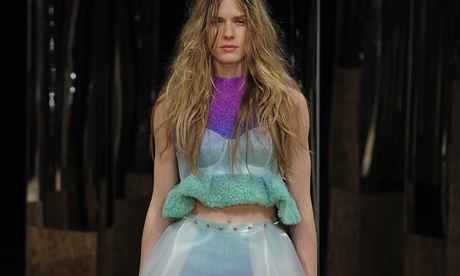London College of Fashion degree show – review

Runway success: Elly Cheng Ka Ying. Photograph: Chris Moore
On a hot evening in late June, all manner of fashion followers descended on Hackney House for London College of Fashion’s School of Design and Technology BA Graduation runway show.
Behind its deceptive façade on Shoreditch High Street the venue was preparing its big top tent for a visual showcase of a selected group of designers working in womenswear, menswear, textiles, jewellery and accessories.
Notable fashion bloggers, journalists and student peers took to their seats in the circus tent, the traditional function of which did not seem inappropriate for the exhibitionist ‘experience’ LCF were aiming to create.
On one side were large upright, mirrored prisms, between which the models would enter the central space; more hung like oversized pendants from above. Stage lighting added further drama to what would be a diverse, and at times, inspiring show.
The collections, of which there were 25 either individual designers or partnered up, opened with menswear by Rory Parnell Mooney and womenswear by Loko Yu, both of whom channelled a dark ‘sci-fi goth’ aesthetic.
Men wore fur rucksacks and heavily layered outwear; the womenswear sought androgyny through exaggerated shoulders and both sported gimp-like nose piercings, not dissimilar to those at Givenchy last season.
It was an appropriate opening – to reference black – the one timeless trend in a notoriously fickle industry. This, in contrast, was followed by an all-white womenswear collection from Isabel Yalda Hellysaz who kept it space-age, mixing simple cotton garments with chunky knits and transparent plastic goggles.
Monochrome was then replaced by Elly Cheng Ka Ying’s womenswear collection, in which models took to the catwalk as if dip-dyed in sherbet. Silicon vests and dyed sheepskin skirts in violet and mint hues were clinched in at the waist and paired with rucksacks – an ongoing theme throughout the show.
There were lots of the right trend references in Cheng Ka Ying’s collection, including 90s nostalgia and a breezy summer palette.
Knitwear designer Lucy Starling used a reversed jacquard weave with muted pink and grey tones to produce a look that was both organic and sumptuous. Cat Patterson played rough with her textures, combining iridescent fabrics in patchwork formations with safety pin vests.
The use of zigzag motifs came from her exploration into the African culture of the Congo. Sleeveless dresses, midi and pencil skirt lengths were popular cuts throughout the whole show.
Tangerine hues and PVC also played a big part in both the menswear and womenswear collections.
Anjie JiMin An’s womenswear felt like one of the most complete and commercially viable collections. The South Korean opted for Japanese biker-cum-schoolgirl, with a navy base, pleats, tartan and black leather detailing on collars and bags.
The pop graphics of Auria x Margret Bowman’s swimwear collaboration and Robert Ventura Gibson’s Masonic motif shirts for men led the way in fresh and inspiring prints.
Lucy Adjoa Armah’s collection explored the versatility and utilitarian elements of fabric. The Newham/Ghanaian designer co-directs arts organization DE/FAULT, running exhibitions from a space at Netil House in Hackney.
There was impressive diversity in the menswear collections, from the bespoke tailoring and attention to detail of Katrin Salem’s ‘Latino Cholo’ inspired collection, to Ema Ranger’s colourfully abstract sportswear.
The Collection of the Year award went to Sebastiaan Pieter Groenen from BA (Hons) Bespoke Tailoring. John Alexander Skelton’s accomplished and accessible collection featured formal long-coats and oversize duffle bags animated with panels in orange and cobalt blue.
SI Leong Chan’s playful ‘hug’ puffa jackets and rucksacks, incorporating multiple pairs of stuffed hands that cradle the wearer, felt playful, despite being inspired by loneliness.
